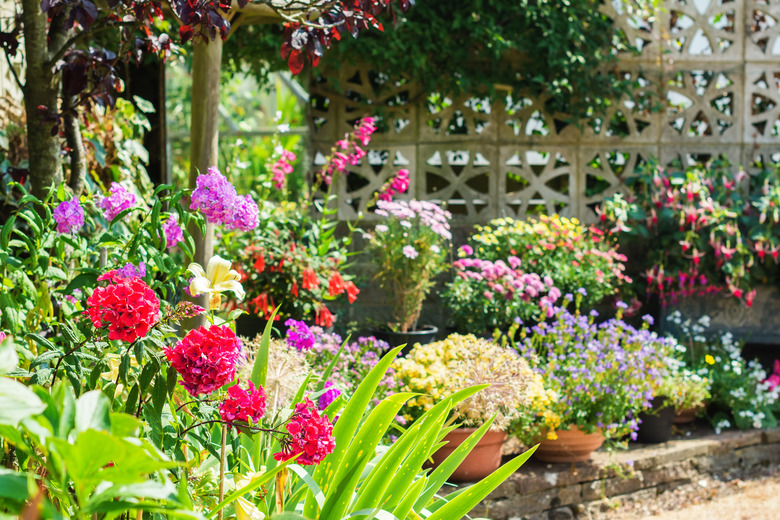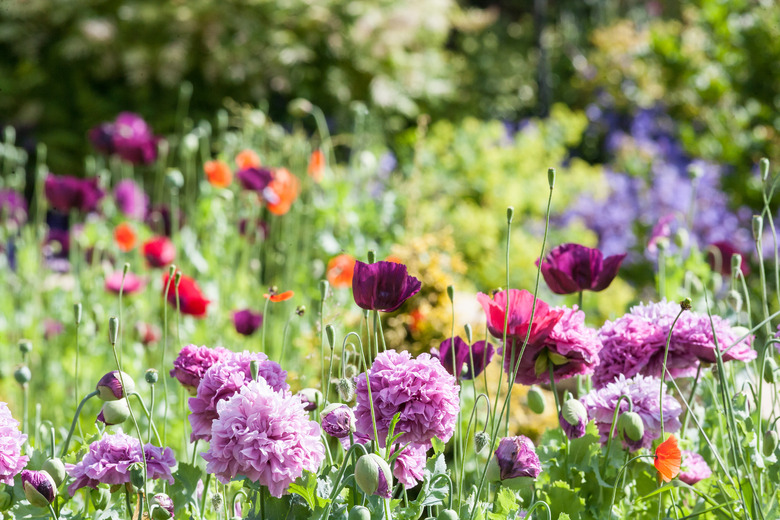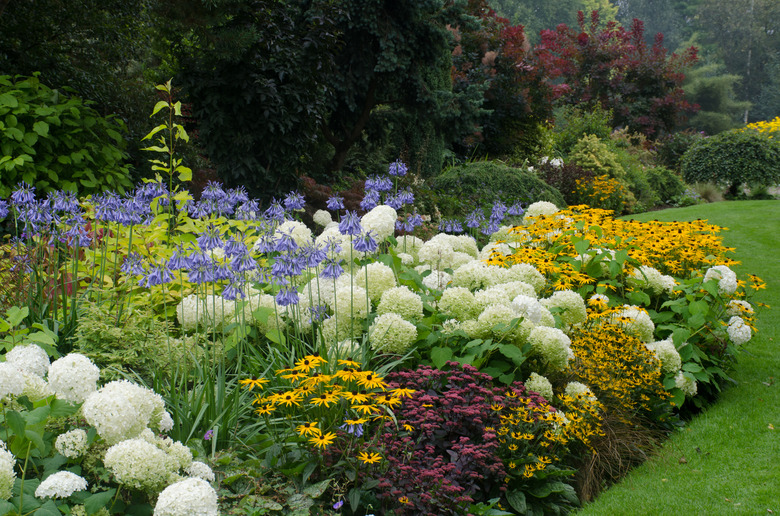Tips For Starting A Flower Garden
We may receive a commission on purchases made from links.
Adding a flower garden to your yard is a good way to introduce color, texture and overall visual interest to the landscaping. A new garden gives you the opportunity to grow flowers of which you are fond or to experiment with new plants — as long as your yard provides the growing conditions that will help the plants thrive.
Those conditions include the type of garden soil in your yard, the amount of direct sun the yard receives and the general climate where you live. If the conditions are right — and you can alter some of them yourself — you can create a flower garden to dress up the foundation of the house or to give you a space where you enjoy spending your time.
Flower Garden Basics
Flower Garden Basics
There are a few factors to consider when choosing the location of your flower garden. Most flowering plants need full sun, which is six to eight hours of sunlight a day, although there are some plants, such as hostas and ferns, that are more shade tolerant and only require partial sunlight. You can find this type of information on the plant tag that comes with potted plants or on the seed packet.
While there are some exceptions, most flowers grow best on fertile, well-draining soil. Learn the true condition of your soil by having it tested at a garden center or by your local Cooperative Extension Service office. These are based at state universities, often with offices in each county, and they can tell you how to take samples for testing.
The results of the soil test tell you the pH of the soil, which is a measure of its acidity and alkalinity. Plants like specific pH levels, but most prefer neutral to slightly acidic soils. There are additives that can help you adjust the pH. The test results will also list the nutrients in the soil and how to improve those that are lacking.
Successful flower gardens also include a variety of beneficial insects. These insects help control harmful insects, and they pollinate flowers.
Flower Garden Drainage
Flower Garden Drainage
Test the draining capacity of your flower garden by digging 12 x 12 x 12-inch holes. Fill them with water and time how long it takes for them to drain. It's best to do this in a few places depending on how large your flower garden will be.
If the hole empties in less than 30 minutes, the soil drains too quickly and probably contains a high amount of sand. Soil that drains in 30 minutes to four hours is best for most plants. If it's longer than four hours, the soil is made up of mostly clay, which will not drain well enough to support the healthy growth of most plants.
You can improve both fast-draining and slow-draining soil by working in organic matter, such as compost or leaf mold. Use a shovel or a garden fork to loosen and turn over about 12 inches of soil and work the organic matter into the soil. The organic matter not only improves drainage but also adds nutrients to the soil.
Choosing Plants for Your Garden
Choosing Plants for Your Garden
For the home gardener, there are two broad categories of plants: annuals and perennials. Annual flowers last for one growing season. Most provide sparks of color that will last throughout the summer. Perennials are long-lived plants that grow for at least several growing seasons, many of which die back in the winter but grow again the next season. They usually have specific bloom times.
While they bloom all summer long, annuals require that you buy and plant the flowers every season. Some perennials will come back year after year for decades. Because they provide a shot of color that lasts a long time, most annuals require more watering and fertilizing than perennials.
Seasoned gardeners tend to gravitate to perennials because of the sense of accomplishment of seeing a plant come back year after year, but plant selection is really a matter of taste. One strategy is to provide structure to the flower garden with perennials, such as black-eyed Susans or daylilies, and fill in with annuals, such as impatiens or dahlias, every spring. Create interest by mixing plants of different colors, bloom times and leaf textures in your flower bed.
Buying Flowers for Your Garden
Buying Flowers for Your Garden
You can buy beautiful flowers at garden centers and home centers, online and from print catalogs. Garden centers usually have knowledgeable people with whom you can speak about suitable plants for your area.
Your county Cooperative Extension Service can offer advice on plants, including the native plants that prosper where you live. These are plants that are indigenous to your area that are adapted to the local moisture, climate, and soil conditions, and they have developed some defenses against local pests and diseases — making them extremely low maintenance. Using native plants is a popular gardening movement, but few gardeners are purists. If they do use native plants, many gardeners supplement them with non-native species.
In addition to the sunlight and soil conditions in your yard, you will also need to know the United States Department of Agriculture (USDA) plant hardiness zone in which you live. The USDA divided the country into 11 hardiness zones. Each zone has an average winter temperature that is 10 degrees above or below the next zone.
When you do make your buying decisions, you can purchase seeds, young potted plants or bare-root stock, which is a dormant form of the plant. Depending on the plant, seeds can be sown directly into the garden, or they can be started during the winter by sowing them in seed-starter kits and then transplanting them in the spring. Transplant young plants and bare-root stock directly into the garden.
The seed packet or the information that comes with the plant will provide the planting information you will need. It will list the USDA hardiness zone, the light and soil requirements and the recommended spacing between plants.
Maintaining Your Flower Garden
Maintaining Your Flower Garden
To coax blooms in your flower garden, be sure to fertilize the plants, based on the results of a soil test. Plant fertilizers are available in a number of forms, such as water-soluble and slow-release blends, and they contain a variety of nutrients, with the most prominent being nitrogen, phosphorus and potassium. The percentage of each is usually listed on the package. Fertilizers for flowering plants usually contain an amount of nitrogen that is equal to or less than the amount of phosphorus because phosphorus promotes blooms and nitrogen promotes green-leaf development.
Apply fertilizers following soil-test recommendations and the package directions when planting and then each spring thereafter. Some plants benefit from a second dose of fertilizer during the summer.
Remove weeds so that they don't compete with your plants for nutrients. To reduce weed growth, apply a few inches of mulch between plants but keep the mulch away from the plant stems. A layer of mulch helps keep the soil moist. There are many different types of mulch, such as compost, wood chips and grass clippings.
Most flowering plants like nutrient-rich soil that is slightly moist, but check the plant tag or seed packet for specifics. Water in the morning so that the foliage has time to dry and you don't lose water to evaporation. If possible, water using soaker hoses or drip irrigation systems. They deliver water right to the base of the plant, reducing evaporation losses.
Promote additional blooms by pinching back or deadheading spent flowers. This won't work for all flowers, but for many, once the flower dies, simply cut it off at its base to encourage new growth. In some cases, you can pinch the stem between your fingers to remove the flower. For some plants, such as geraniums, you need to cut off the stem that supports the flower as well. If the stem is dry and brittle like the flower, remove it.


